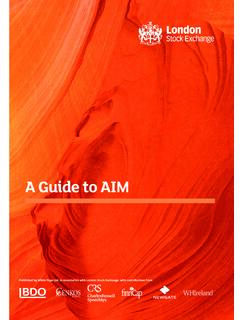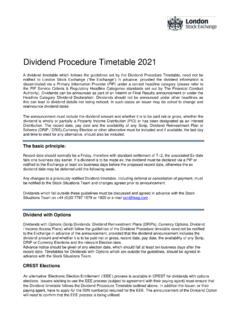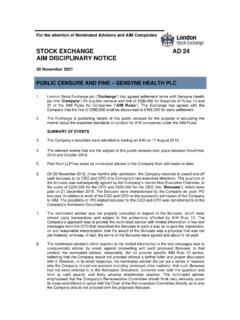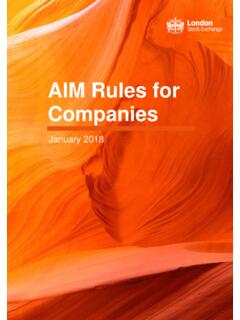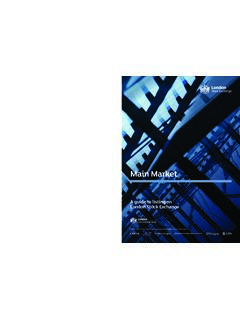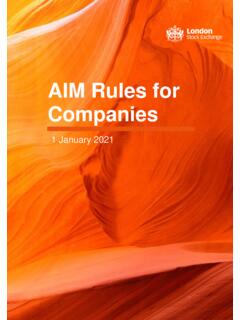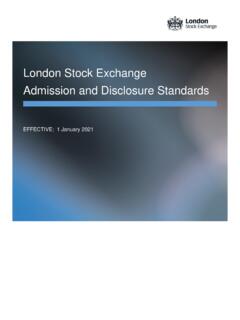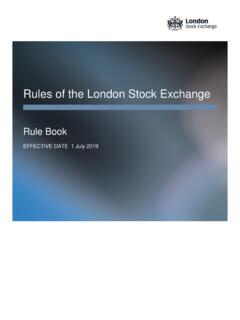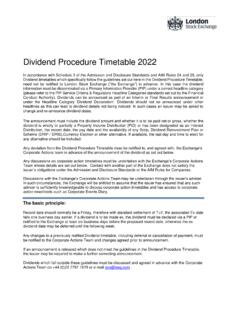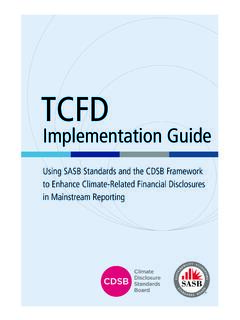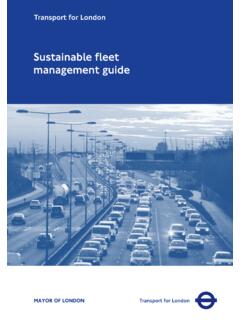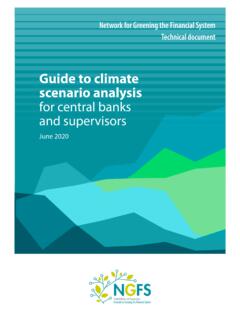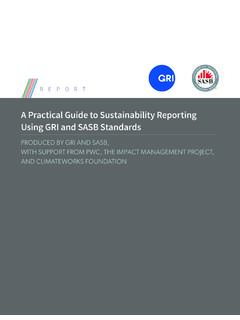Transcription of Your guide to climate reporting
1 An LSEG BusinessUnderstanding climate risk and opportunityYour guide to climate reportingGuidance for London-listed companies on the integration of climate reporting best practice and TCFD guide to climate reporting Contents Foreword 3 Executive summary 41. climate disclosure the strategic picture 102. Risks and opportunities climate risks climate opportunities Integrating climate into internal processes and governance Scenario analysis Scenario selection Simplified approach for first-time scenarios How detailed should climate reporting be?
2 303. Investment grade data: metrics and targets Investor-useful information reporting on opportunities Carbon emission reporting Setting targets Targeting net-zero emissions reporting template for climate targets Transition plans develop and disclose 454. Global frameworks Frameworks for disclosure Data verification and assurance Location and timing of climate -related disclosure 495. Regulation in the UK and global taxonomies TCFD in the UK: a work in progress Developing taxonomies globally EU taxonomy and the Green Revenue Classification System Other taxonomies and disclosure regimes 54 Conclusion 55 Annex 1: TCFD Checklist 57 Annex 2: Alignment of recommended disclosures 65 with other frameworks Annex 3: Sustainability reporting frameworks 69 Annex 4: LSEG carbon targets disclosure template 732 Rarely have investors, policymakers and regulators been more united in a single message to the business world: sustainability is no longer a nice to have.
3 In fact, four in five asset owners told us it is now integral to how they allocate capital, and for two thirds of them, climate and carbon is their top sustainability s listed companies have responded to these demands impressively in recent years and are some of the best climate reporters in the world. But why shouldn t every large or listed company in the UK voluntarily provide climate -related data? That would make our companies more attractive internationally and strengthen our economy against the inevitable challenges of climate change on the pioneering work of the Task Force on climate -Related Financial Disclosures (TCFD), LSEG (London Stock Exchange Group) has created a practical and comprehensive guide to help companies do exactly stock exchanges around the world are drawing up similar TCFD-aligned guidance to meet the needs of their home markets, following the work of the UN Sustainable Stock Exchanges initiative which launched Model Guidance for exchanges and listed companies earlier this believe as global exchanges publish their guides in the months and years to come, thousands more companies will begin reporting their climate -related data getting ahead of an inevitable increase in mandatory reporting in countries around the world.
4 That in turn will accelerate investors re-allocation of capital towards those that are doing the most to decarbonise and transition to a low-carbon believe this guidance is an important new tool in equipping London-listed companies for a world in which investor demands, consumer attitudes and regulatory requirements are changing fast. This, I hope, will ultimately provide further impetus to all our efforts to address climate guide to climate reporting3 ForewordDavid SchwimmerChief Executive Officer, LSEG ForewordExecutive summary 4 Your guide to climate reportingExecutive summaryThe global economy needs to undergo an industrial transition to rapidly decarbonise, with huge implications for business and the investment community. The finance and investment sectors are increasingly re-allocating capital to reflect this, moving capital away from companies with potentially unaddressed climate risks and towards those with clear plans for a transition to a low-carbon economy, as well as those actively operating in Green Economy growth markets.
5 The finance sector is also in the spotlight, given its critical role of mobilising finance in support of the transition to is vital that companies are able to effectively disclose and communicate their approach to climate change, their strategies, and how they are managing associated risk and opportunity. Investors require high quality, globally consistent data to inform their investment strategies and how they allocate a global exchange we have an important role to play in supporting companies on our markets to understand how to approach and communicate this information. The effective flow of climate risk information enables better capital allocation and engagement between companies and investors. It will also help to improve the climate resiliency of global capital market participants are developing a more sophisticated understanding of how to price risks relating to climate change and demanding higher quality, consistent and comparable data to inform their decisions.
6 This requires a dramatic improvement in climate -related reporting globally. The Financial Stability Board (FSB) established the Task Force on climate -Related Financial Disclosures (TCFD) to develop recommendations that help companies assess, manage and report on climate change-related risks and opportunities within their financial accounts, using an approach that demonstrates a clear understanding of the most material issues and the plans in place to address increasingly demand more precise detail of companies climate strategy and carbon emissions and regulators including the UK s Financial Conduct Authority (FCA), are making disclosure in line with TCFD mandatory, beginning with premium-listed companies and with a roadmap that is likely to include all sectors and sizes.
7 The most recent consultations set out the regulator s proposals to extend climate -related disclosures rules to companies with a standard listing and to asset managers, life insurers, and FCA-regulated pension providers. This approach would also accelerate TCFD-aligned disclosure amongst privately-owned companies and assets within portfolios of mandated to improve reporting on other extra-financial issues relating to environmental, social and governance (ESG) practices continue to be developed. While there is significant overlap between climate issues and broader ESG issues, it is important the distinction is understood given the urgency around addressing the climate emergency, demand for this data from the investment and finance sector, and also Your guide to climate reporting5 Executive summaryThe effective flow of climate risk information enables better capital allocation and engagement between companies and guide to climate reporting6 Executive summarySTEP 1 Disclosure diagnosis and contextThe first step to ensuring that climate -related issues are sufficiently addressed by your organisation is to understand the relevance of climate change and take stock of your current strategy and disclosure practices.
8 To help companies understand the key climate -related considerations for their business, this guidance provides an overview of the evolution of climate -related disclosures and the current financial, political and regulatory landscape. In order to help companies evaluate their current disclosure, this guidance also provides a checklist (Annex 1) which helps companies determine whether or not they are providing sufficient information to 2 Integration of climate -related risks and opportunitiesOnce management recognises the context and need for action on climate change for their organisation, they can begin to integrate climate -related considerations into their risk assessment and strategy development processes (see Chapter 2). climate change has implications for all businesses irrespective of industry.
9 This integration should be done from the top of the organisation and should filter down through policies, processes and for climate reporting we have a clear single global framework in the TCFD this, the London Stock Exchange has put together this guidance on TCFD reporting to support best practice and to educate companies on how they can implement these recommendations. It complements and cross-references a separate LSEG publication: Revealing the full picture: Your guide to ESG Used together, these guides can help companies understand and deliver best practice on disclosure to investors, prepare for regulation and derive commercial value from improved management guidance is not a deep technical document, but a broad overview intended to help companies understand the issues, grasp how they might apply in each company s own case and take steps towards gathering and reporting the relevant information.
10 It is designed for all companies listed on the London Stock Exchange s markets, regardless of their sector, size or the stage of their transition help companies integrate and communicate climate -related information in alignment with TCFD s recommendations, the following three-stage process is helpful: 1. guide to climate reporting7 Executive summaryeconomy, as well as expanding the guidance on emissions disclosure to include emissions in the supply chain (so-called Scope 3 emissions).Who should use this guidance?Whilst this guidance is specifically written to support companies on the London Stock Exchange s markets, all companies should find it helpful and are encouraged to use these recommendations to ensure the information they are communicating with investors and wider stakeholders is both consistent and useful by addressing the most financially-material aspects of climate change to their three-stage, cyclical process can be undertaken by any company, regardless of size or sector.
